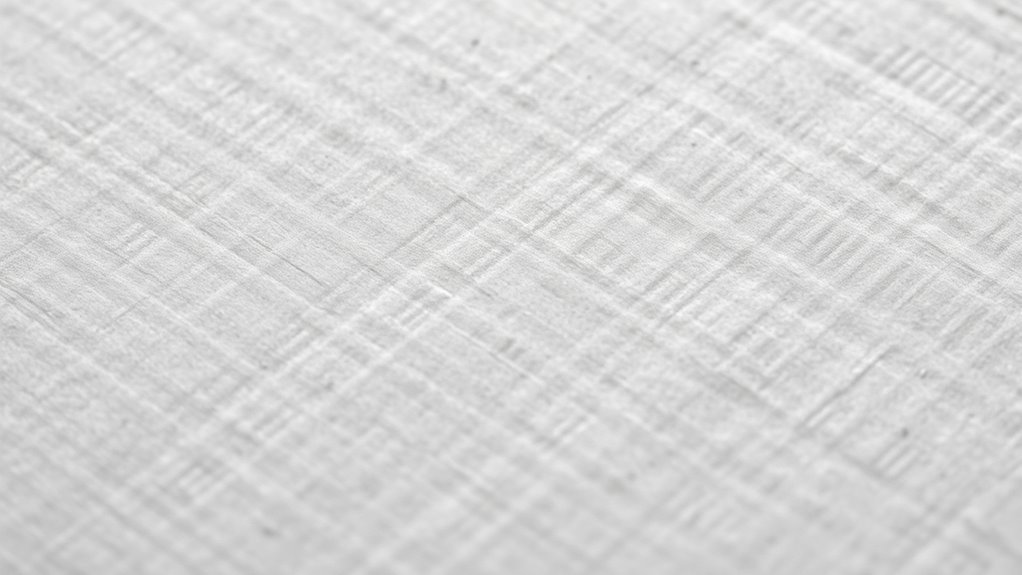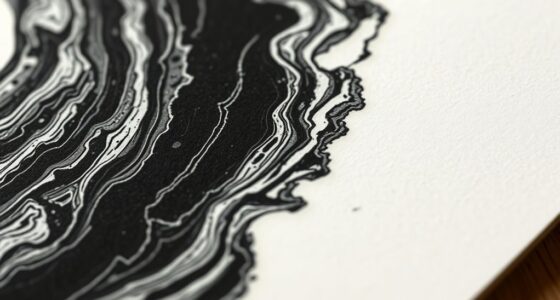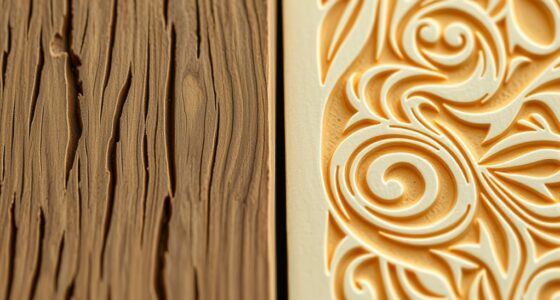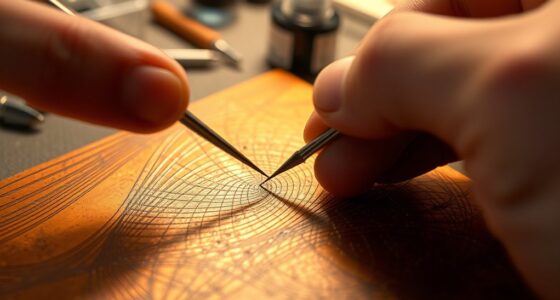Understanding paper grain direction is essential because it affects how your paper behaves during cutting, folding, and printing. When you cut along the grain, you’ll get cleaner, more accurate edges, while cutting against it can cause tearing or fraying. Folding along the grain produces neater creases, and knowing the fiber orientation helps you handle the paper better overall. Keep exploring to discover how mastering grain direction improves your projects.
Key Takeaways
- Paper grain runs parallel to fiber orientation and affects folding, tearing, and strength during handling.
- Cutting with the grain produces cleaner edges, while against the grain risks tearing and fraying.
- Folding along the grain results in neater creases and prevents uneven or jagged folds.
- Recognizing fiber direction helps optimize cutting, reduce waste, and improve overall project quality.
- Flexing the paper easily reveals the grain, aiding in proper alignment for printing and finishing.
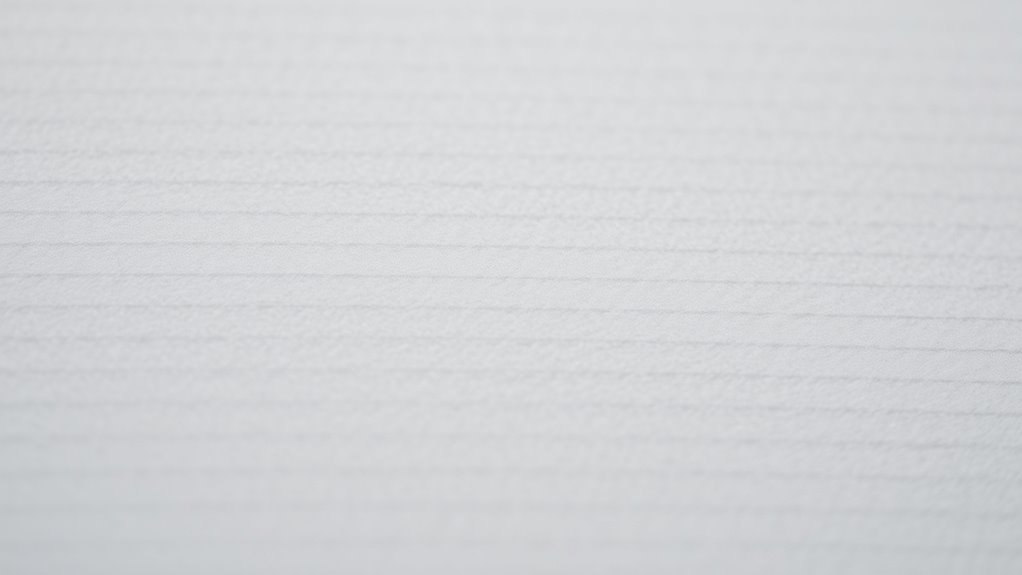
Understanding paper grain direction is vital because it affects how paper behaves during printing, folding, and processing. When you handle paper, recognizing its grain orientation helps you make smarter choices, especially regarding cutting techniques. Paper has a natural grain that runs parallel to its fibers, which influences its strength and flexibility. If you don’t pay attention to the grain, you might encounter issues like uneven tears, warping, or difficulty folding accurately. For example, cutting against the grain can cause the paper to tear or fray more easily, leading to jagged edges or wasted material. Conversely, cutting with the grain results in cleaner, more precise edges, saving you time and effort during finishing.
To optimize your projects, always check the grain direction before making any cuts. You can usually determine the grain by gently flexing the paper; it will bend more easily along the grain. Many printers and designers recommend aligning your cuts with the grain to ensure the best results. When you’re preparing to cut large sheets, think about how the grain runs across the paper and plan your cuts accordingly. This strategic approach minimizes waste and improves the overall quality of your final product. Additionally, the grain orientation impacts folding; folding along the grain produces a cleaner, neater fold, while folding against it might cause cracking or uneven creases. If you’re creating book covers, brochures, or cards, this detail can make a visible difference in the finished appearance.
The choice of cutting techniques plays an essential role in how well your project turns out. When you cut with the grain, you’ll notice smoother edges and less fraying, which is especially important for high-quality prints or delicate materials. Using sharp blades and proper cutting tools aligned with the grain ensures precision and reduces the risk of damaging the paper. If you need to cut across the grain, consider scoring the paper first to weaken the fibers and make the cut cleaner. This method is particularly useful when you’re working with thicker or more fibrous paper types, such as cardstock or heavy-weight paper stocks. By understanding the grain and applying the right cutting techniques, you gain better control over your project, resulting in a professional-looking finish every time. Recognizing the natural fiber alignment of paper helps you anticipate how it will behave during handling and processing.
Frequently Asked Questions
How Does Paper Grain Direction Affect Ink Absorption?
When you print on paper, ink absorption impacts print clarity and overall quality. If you choose the right paper grain direction, you’ll notice better ink absorption, resulting in sharper images and clearer text. Proper alignment also enhances paper strength, reducing warping or tearing during printing. By paying attention to grain direction, you guarantee your prints are crisp, durable, and professional-looking, making your work stand out with excellent print clarity.
Can Grain Direction Influence the Paper’s Durability?
Yes, grain direction can influence your paper’s durability. When you align the grain with the stress points, it enhances grain strength and tear resistance, making the paper less prone to tearing or damage under pressure. Conversely, if the grain runs perpendicular, the paper may weaken, reducing its overall durability. So, paying attention to grain direction helps you choose stronger, more durable paper for your specific needs.
Is Grain Direction Important for Digital Printing?
Did you know that 70% of print quality issues stem from improper paper handling? Grain direction is vital for digital printing because it affects the paper’s grain texture and surface finish. When your paper’s grain runs parallel to the print direction, you get smoother results and fewer jams. Ignoring this can cause misaligned images and uneven ink absorption, so always consider grain orientation for sharp, professional digital prints.
How Can Grain Direction Impact Folding and Binding?
When you consider how grain orientation impacts folding and binding, you’ll see it directly affects fold strength. Folding against the grain can cause cracking or weak folds, making your project less durable. By aligning your paper’s grain direction with the fold line, you guarantee stronger, cleaner folds. This improves binding integrity and overall quality, preventing damage during handling and use. Paying attention to grain orientation helps you achieve professional, long-lasting results.
Does Grain Orientation Vary Between Different Paper Types?
You might wonder if grain orientation varies between paper types. It often does, depending on manufacturing standards and processes. Manufacturers aim for consistent grain directions within each paper type to guarantee quality, but variations can occur due to different fibers, production methods, or raw materials. This variability affects how the paper behaves, especially when folding or binding, so checking grain consistency is vital for achieving the best results.
Conclusion
Understanding paper grain direction is like knowing the secret rhythm of a dance—it guides your every move. When you align your work with the grain, your projects flow smoothly, avoiding tears and wrinkles. Ignoring it, on the other hand, can turn your effort into a frustrating maze. So, pay attention to the grain’s direction; it’s the heartbeat of perfect paper work, turning what could be chaos into a symphony of precision and beauty.
